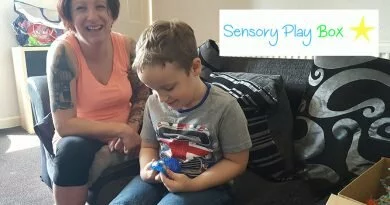5 Things You Can Do To Encourage Autism Acceptance in 2019
By now you’d have to have been living under a rock not to have heard of autism. There have been a lot of very popular positive campaigns by major charities such as the National Autism Society’s Too Much Information and World Autism Awareness Week. These campaigns have put autism squarely in the public eye over the last few years.
Sadly, autism has also made news for plenty of bad reasons, most prominently due to the false association that autism sadly still has within the anti-vaccine movement (vaccines still don’t cause autism, in case you were wondering). This is the appalling legacy of Dr Andrew Wakefield, a British surgeon that performed unscrupulous experiments to provide flawed data that would ultimately point the finger of blame at MMR vaccinations as a cause of autism in children. This and the movement it has generated have had a hugely negative impact, not just on the increase of vaccine-preventable disease but also on the public perception on the causes of autism.
There have also been plenty of stories of mistreatment and even death of autistic individuals in care. Only last month we saw the details of how Amanda Briley and Clive Treacey were among 40 people who died while admitted to hospital under an initiative for people with learning disabilities and autism.

So it’s safe to say that we should all certainly be aware of autism. But is awareness enough? Does it contribute positively to the lives of autistic adults and children? Evidence suggests that we still have a very long way to go. Only this year we saw a misguided attempt at positive representation backfire spectacularly when the theatre production All In A Row was publicised to almost universal outcry within the autistic community. In a stupifying display of (perhaps well-meaning) ignorance the play portrayed an autistic character with a lifeless felt puppet in a play otherwise entirely comprised of human actors. Autistic people immediately jumped on this, pointing out the dehumanising nature of that choice.
What is really needed is autism acceptance. We need to appreciate the adjustments that we need to make to society to make life easier for autistic individuals and their families.

That’s why this is a list of five things that we can do to help encourage the public awareness of autism acceptance in 2019. I don’t think just knowing about autism is having the necessary effect on our society and our appreciation of the autistic experience. We need to be profoundly familiar with how autistic people experience the world differently to neurotypical (non-autistic) people.
Before I go any further, I need to state my situation so you know what my stake in all this is. I am not autistic. I am the father of a 7 yr old boy who was diagnosed with ASD at 3 yrs old and as such autism has been a huge part of our family life for a long time now. My son has what you’d loosely consider to be quite ‘severe’ autism. That’s not to say he’s ‘low-functioning’ which is mostly a useless term. It just means that it affects him in a lot of ways and has required us to make a lot of changes to ensure he’s happy. He has issues with sleep, diet, stress, anxiety and emotional stability as well as sensory issues. Having developed speech quite late, he now intermingles conversation with scripting and echolalia which can often make conversation challenging. He has fixations on things to the point it can become difficult to manage. He can find some environments hugely challenging meaning there are some things we can’t do as a family and places we can’t go.
Despite all this I have never seen autism as something inherently negative, it’s a part of who my son is. Without it he would be completely different and I love who he is right now. Does he experience huge challenges? Yes. Do I wish he had an easier time of it? Totally. But would I change him? Hell no! The change that’s needed is from society. It’s my responsibility as his father to do whatever I can to give him a great life and to try to ensure he is in an environment that allows him to thrive. That’s why I want a society that is truly accepting of autism and of neurological difference.
So, here’s my five things neurotypical or non-autistic people can do to help autistim acceptance.

1. Listen to autistic voices
For all the help, advice and advocacy that I can offer here, the best source of information will always be from autistic people themselves. Many autistic people are fully able to advocate for themselves and to enter into meaningful discussions about what they need from an accessible society. All we need to do as non-autistic people is learn to listen to them.
There are many autistic voices on Twitter. You can usually find these under the #actuallyautistic hashtag. Some of my favourites include Neurodivergent Rebel (@NeuroRebel), Agony Autie (@AgonyAutie) and The Autistic Advocate (@KieranRose7). They make a lot of really decent content about their first-hand experience of being autistic and the changes that need to be made to ensure society works for autistic and non-autistic people alike.
So talk to autistic people, listen to how living in a society of predominantly non-autistic people effects their day-to-day lives, how it may often prohibit them from living a happy or successful life and how it might contribute towards their own stress and anxiety.

2. Try to empathise with autistic people
By this I mean try to understand how everyday situations might be different or more challenging for someone on the autistic spectrum. Things that we as non-autistic people may not even notice can be hugely obstructive to autistic people.
From a purely sensory perspective, many environments and public spaces are just not suitable for autistic people. Places with glaring fluorescent lights, strong smells or intense sounds can be too much for an autistic person to deal with.
Imagine having to go to a busy shopping mall or a hospital waiting room. Think of all the sensory input that those places contain. It can quite often be a bit much for people without sensory issues so imagine how distressing that can be for someone who’s sensitive to those things.
One place that used to cause issues for us was the cosmetic retailer LUSH. LUSH are easily the stinkiest store on the high street and the combination of so many strong, perfumed smells was a lot for our son to deal with. Luckily for us, his olfactory sensitivities are not as strong as they used to be (he’s now mostly affected by auditory input) and he now really enjoys going in there as staff will often let him drop a bath bomb in water and he loves letting it fizz in his hand.
Another place was the Disney Store. Like many stores they have bright lights but the effect is amplified by the fact they have glitter embedded in the floor. This makes it difficult to avoid visual over-stimulation even if looking down!
Many places now recognise the need to make changes so that autistic people can access them without issue. Stores such as Sainsbury’s and Morrisons now operate ‘autism hours’ during which visual and auditory noise is reduced. I think it’s a huge step in the right direction but when you consider that these are often one hour a week, I think a lot more needs to be done. How acceptable would it be if a store only put a ramp outside their store for wheelchair users for one hour a week? Change needs to be implemented that makes these places accessible ALL THE TIME. Also, the autism hours tend to be really early in the morning which, if you’re a parent of an autistic child, you’ll realise are not usually the best time to go shopping.
So, as an ally of autistic people, try to identify these situations and join autistic people in campaigning for reasonable adjustments to make these places accessible.
There are also non-sensory situations that can be challenging for autistic people. People with autism often require additional processing time for tasks or in conversation. This can make it difficult for them to contribute in conversations and situations that don’t allow for that. When in situations like this, either socially or at work, try to think how a person who requires additional processing time might be excluded.

3. Be an advocate/ally
When I say advocate, I have to be really clear. This doesn’t mean speaking for autistic people when they are capable of speaking for themselves. The best person to speak for an autistic person is they themselves. Instead, focus on ensuring that autistic friends and colleagues are afforded the time and patience to have their voices heard.
If you have authority to make meaningful changes in your workplace, use that authority to ensure that the needs of your autistic colleagues are met. Most companies should have initiatives to ensure that disabilities are respected in the workplace. Use these to highlight processes or practices that are obstructive to your autistic colleagues.
I have worked in places that really should have had their heads screwed on properly when it came to respecting differences but I still saw autistic prejudices amongst my colleagues. I saw managers talking openly with visitors about my autistic colleagues in terms of their autism, not their professional abilities. I saw autistic colleagues railroaded by aggressive managers who knew they could exploit their behaviours where a non-autistic person would have had the social confidence to say no.
It’s our job as allies to identify these prejudices and point them out. It’s our responsibility to ensure that situations are not perpetuated that disenfranchise neurodivergent colleagues and prevent them from achieving their goals, either socially or professionally.

4. Involve autistic people in decision making
One of the worst types of autism awareness is the proliferation of campaigns and organisations that ignore autistic voices and choose to speak over them. One of the best organisations is ASAN, the Autistic Self Advocacy Network. They are run by autistic people and are a great source of resources and information, all of which is produced by or with the involvement of autistic people.
By comparison, Autism Speaks is a huge autism charity but they have no autistic people in positions of power within their organisation and are almost universally hated by the autistic community. They make decisions that affect huge numbers of autistic people and by doing so without the involvement of autistic people, they are silencing autistic voices.
You can help by making sure autistic people are given agency in decisions that affect them. Whether this is in your workplace, in local charity organisations or even just in supporting national campaigns that are run with the involvement of autistic people themselves.
It is not our job as non-autistic people to take up roles that could better be represented by an authentic autistic voice. I know this may seem odd for me to say as a vocal non-autistic advocate but I consider my responsibility to be to signal boost and signpost towards autistic sources. If I was ever in a situation where my input was invited in a public space, I would be mindful if that would be better served by the input of an autistic person.

5. Don’t support damaging campaigns and organisations
This one is really important. As ‘autism awareness’ raises the profile of autism, there are plenty of organisations acting against the interests of autistic people. Most of these believe they are acting in good faith but they are frequently ignorant of autistic voices and choose to perpetuate bad practices and ultimately profit from the mistreatment and misrepresentation of autistic people.
The main offender here is Autism Speaks. Autism Speaks is an American autism charity started by Bob and Suzanne Wright, grandparents of a child with autism. They have earned themselves the ire and anger of the autistic community by continually promoting autism as a burden on the lives of non-autistic people. They have devoted thousands of dollars donated in good faith towards research looking for a cure for autism. Money which should have gone towards supporting autistic people and their families.
Autism Speaks also started the popular ‘Light It Up Blue’ campaign that encourages people to wear blue to support autism. This is hugely damaging. Not only does it funnel more money in donations to Autism Speaks but by using the colour blue it continues to proliferate the idea that autism is a condition that only affects men and boys. This can also be seen in Autism Speaks overall brand which is depicted using a blue puzzle piece (we’ll get to those in a bit).
Instead of ‘lighting it up blue’, the autistic community have come up with their own alternative campaigns. The two most popular of these are #RedInstead and #LightItUpGold. These have far greater involvement with autistic people themselves and help to steer people away from supporting the damaging influence of Autism Speaks.
I mentioned puzzle pieces. Puzzle pieces have been a staple of autism messaging for a long time. This is also something popularised by Autism Speaks and is widely derided by the autistic community. The use of a puzzle piece suggests all sorts of negative connotations. It suggests that autism is a mysterious, unfathomable puzzle to be solved (it’s not). It suggests that autistic people are somehow missing something that non-autistic people need to find to make them ‘whole’ (they’re not). It also supports messaging around a ‘cure’, as if that missing piece is a cure that will make them a ‘normal’ person again. None of this conjures any ideas about autism that is even remotely helpful or constructive.
A preferred icon that has begun to be adopted is the combination of the rainbow and the infinity symbol. Both of these reflect the broader spectrum on which autistic people can be more adequately represented.

Lastly, one thing that continues to plague autistic people is the popularity of Applied Behaviour Analysis (ABA). ABA is frequently advertised to parents of autistic children as a therapy to enable autistic children to function more successfully in social situations. This is a fallacy that preys upon the insecurities of parents and it is hugely damaging to the wellbeing and mental health of autistic children.
ABA is nothing short of normalisation. It attempts to crush autistic children into a model of behaviour that forces them to emulate neurotypical behavior whilst denying them the comfort of calming methods such stimming. It is hugely damaging as it forces the child to conform to an unnatural set of behaviours without any understanding of why they have to act in that way (outside of the idea that their natural behaviours are shameful or ‘disruptive’.
Children that have been through intensive courses of ABA have displayed ‘normalised’, socially acceptable behaviours only to later have a full mental and emotional breakdown because of the stresses this enforced ‘masking’ has on them.
A campaign that deserves highlighting is Kieran Rose’s #Take The Mask Off campaign, which highlights the ways autistic people have to hide their stims and autistic nature for the sake of ‘fitting in’ and encourages them to stop masking and be their beautiful autistic selves.
So that’s my epic-length explanation of how I, as a non-autistic person, thinks we can be the best possible advocates for autistic acceptance. Autism Awareness just isn’t enough, we need to start changing society and meaningful changes so that autistic people have the best chance at parity of opportunity. That can only come from a society that truly accepts difference and engages with autistic people as equals.
As always I’d be really keen to hear what you think. Am I right or way off base? Are you an autistic person that wants to add/correct something or a non-autistic person that is getting to grips with how to be a decent ally? If so please let me know in the comments below or find me on Twitter at @dadgeekuk.
Love as always!
Leigh





This is a great post. I was really awakened to the in and outs of Autism with my nephew. I also thing we should do more as a society to accept Autism. Also it’s such a wide spectrum and quite often people are just known as ‘autistic’ without understanding the specific needs of that person which I think is frustrating for the autistic person and the family as it’s not one size fits all .